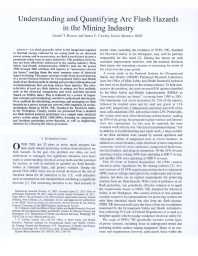Mining Publication: Understanding and Quantifying Arc Flash Hazards in the Mining Industry
Original creation date: November 2011
Arc flash generally refers to the dangerous exposure to thermal energy released by an arcing fault on an electrical power system, and in recent years, arc flash hazards have become a prominent safety issue in many industries. This problem, however, has not been effectively addressed in the mining industry. Mine Safety and Health Administration (MSHA) data for the period 1990 through 2001 attribute 836 injuries to "noncontact electric arc burns," making them the most common cause of electrical injury in mining. This paper presents results from several elements of a recent National Institute for Occupational Safety and Health study of arc flash hazards in mining and provides information and recommendations that can help reduce these injuries. The characteristics of past arc flash injuries in mining are first outlined, such as the electrical components and work activities involved (based on MSHA data). This is followed by a review of important concepts and terminology needed to! understand this hazard. Next, methods for identifying, measuring, and managing arc flash hazards on a power system are covered, with emphasis on recommendations found in NFPA 70E, Standard for Electrical Safety in the Workplace. Finally, results are presented from a detailed arc flash hazard analysis performed on a sample mine electrical power system using IEEE 1584-2004a, focusing on components and locations presenting severe hazards, as well as engineering solutions for reducing the risk to personnel.
Authors: GT Homce, JC Cawley
Peer Reviewed Journal Article - November 2011
NIOSHTIC2 Number: 20040087
IEEE Trans Ind Appl 2011 Nov-Dec; 47(6):2437-2444
See Also
- Arc Flash Awareness
- Detrimental Effects of Capacitance on High-Resistance-Grounded Mine Distribution Systems
- Early Detection of Insulation Failure in Electric Motors
- Electric Shock Prevention
- Electrical Accidents in the Mining Industry, 1990-1999
- Electrical Safety
- Mine Power Systems
- Practical Risk Assessment Guidelines for Identifying, Assessing, and Mitigating Stored Energy Hazards in Underground Coal Mines During and After a Mine Emergency
- Protecting Miners from Electrical Arcing Injury
- Reducing Non-Contact Electric Arc Injuries: An Investigation of Behavioral and Organizational Issues
- U.S. Bureau of Mines/NIOSH Mining Electrical Safety Research: A Legacy of Protection Against Shock, Fires, and Explosions
- Content source: National Institute for Occupational Safety and Health, Mining Program


 ShareCompartir
ShareCompartir
